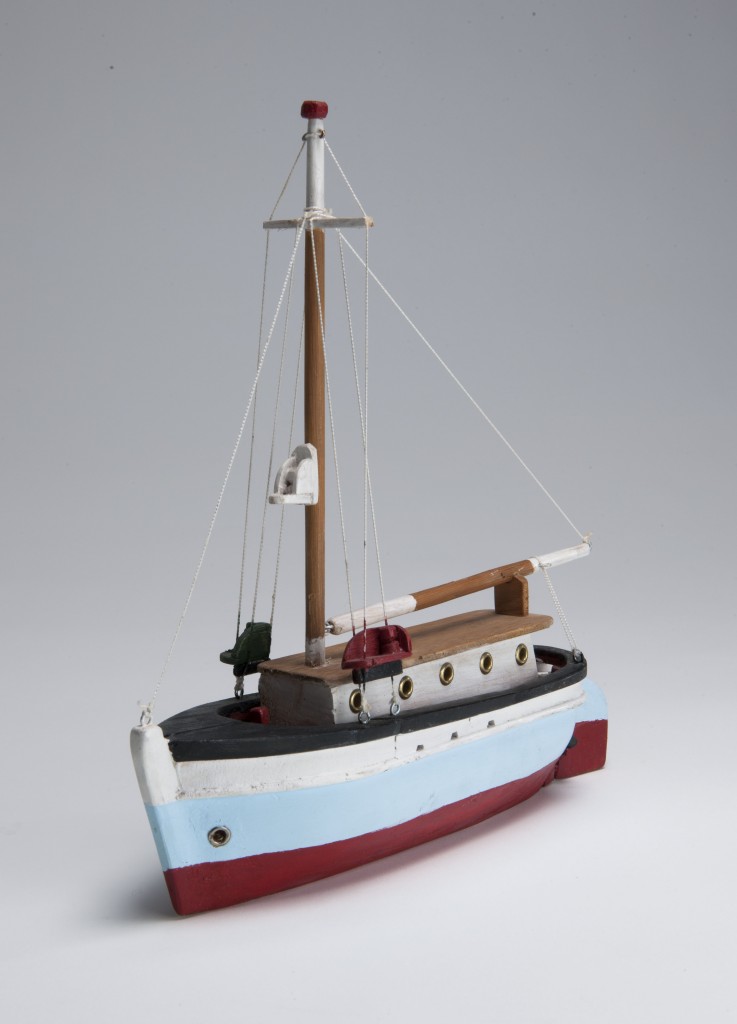Expanding on The Empress Part 1: The Pilots of Pointe-au-Père

Model of pilot boat from Pointe-au-Père. Canadian Museum of History, 2014.0014.0043.1. This boat operated between the shore at Pointe-au-Père and the ships out in the channel. Beginning in 1960, the pilot station was moved to the north shore community of Les Escoumins, where to this day pilots are still taken on and off the passing vessels.
The old pilot schooner
This model of a schooner (goélette) was acquired from the Musée des bateaux miniatures of Rivière-du-Loup in 2012. It depicts the wind-powered schooner (also equipped with a motor) that was used to carry pilots back and forth from the ships entering and leaving the St. Lawrence River at Pointe-au-Père during the late 19th century. Measuring 28 centimetres high and about 29 centimetres long, this wood-carved object tells an interesting story of a place, Pointe-au-Père, and of a community of pilots that, for three centuries or more, have worked the boats plying the waters of the St. Lawrence River. These pilots fulfilled the essential service of safely steering vessels up or down a hazardous and very busy waterway.
The model represents the first pilot boat at Pointe-au-Père. That boat belonged to John McWilliams, who became the local lighthouse keeper in 1876. As a sideline, he built a boat to carry pilots to and from the ships that navigated the river. The initiative may have been a joint venture involving McWilliams himself and Peter Rouleau, the harbour master for Pointe-au-Père and Rimouski. The service was introduced decades before Pointe-au-Père was officially chosen as the main lower St. Lawrence pilot station in 1905, succeeding the older pilot station of Le Bic.
Pointe-au-Père is located 30 kilometres downstream from Le Bic, a pilot station on the lower St. Lawrence that had existed since the late 18th and early 19th centuries. Some pilots went to Pointe-au-Père instead of Le Bic beginning in 1859, when the Montreal Ocean Steamship Company — or the Allan Line as it was known — began using Pointe-au-Père as the base for its pilots during the navigation season. The Allan Line had recently introduced a weekly mail service between Canada and Europe, and built new ships specifically for this purpose. A lighthouse was erected at Pointe-au-Père to minimize the risks to shipping on the St. Lawrence. A number of other lighthouses were built upriver, notably on the Pilgrim Islands and the Kamouraska Islands during the 1860s, at the insistence of shipping companies and the Québec City Chambre de commerce. The Allan lighthouse was eventually taken over by the federal government. The lighthouse burned down in 1867 but was rebuilt later the same year. It was equipped with a fog gun to help orient ships as they navigated up and down the river.
In 1876, McWilliams became the second lighthouse keeper at Pointe-au-Père. He was 21 years of age at the time. Pilots appreciated the convenience his schooner offered by ferrying them back and forth from the ships. There was no pier at Pointe-au-Père, so pilots were likely picked up or left off by a jolly boat. Although perilous in rough weather, they may have found McWilliams’s schooner more convenient than the vessel maintained by the Corporation of St. Lawrence Pilots at Le Bic. If the tide permitted, the Corporation’s craft would exit the Bic River and surrounding bay and sail around Biquette Island before reaching open water. The other option was for the boat to remain out in the open water, at all times making it vulnerable to inclement weather or, in cases of dense fog, possible collision with other vessels. Access to vessels from Pointe-au-Pere, on the other hand, was more direct: they were right in the channel just beyond the shore. It was easier to come and go and not lose sight of the ships in need of a pilot.
John McWilliams left his mark on the community of Pointe-au-Père, serving as mayor during the 1890s and 1900s. He retired from lighthouse work in 1911. In the manuscript census for that year, he is described as a 55-year-old lighthouse keeper and a télégraphiste of Scottish descent and Anglican religion living with his niece and two servants. His son David, a mechanic and telegraph operator, wife Nora and their 1-year-old son lived next door. John McWilliams died in 1921, and was buried in the Anglican cemetery of Rivière-du-Loup,
By 1914, Pointe-au-Père had become a hamlet of navigators, wireless operators, lighthouse keepers, sailors, farmers and seasonal workers numbering about 70 families. Life revolved around the seasonal contours of the navigation business. Many in Pointe-au-Père held two jobs: one somehow associated with maritime navigation in summer and another, perhaps inland, in winter. These people lived, worked and socialized together.
On May 26, 1914, two days before the Empress of Ireland left Québec City on its fateful journey, a reception was held to honour the marriage of Willie Goulet, a sailor and part-time lumberjack, to Anne Lagacé, both residents of Pointe-au-Père. Goulet, aged 22, was the eldest born of Walston Goulet and Eugénie Poirier. Anne, 6 years older, had been a servant in the household of Pierre Ross, navigateur. The wedding party was a moment of pure celebration, but it also offered a chance for members of the local community to bond together. How could they know that disaster would strike just 48 hours later?
When disaster did arrive and the Empress of Ireland sank on May 29, 1914, it was McWilliams’ despatch that travelled the news wires. His account of the events of what remains the worst maritime disaster in Canadian history appeared in the next day’s edition of the New York Times.